




Resonant Transmutation of Metals in Human Blood
The Quantum Trappings of a Golden Age - Part 1
by Alex Putney for Human-Resonance.org
June 6, 2012 - Updated on October 28, 2013
Intensifying atmospheric ionization has generated spectacular auroral displays in recent months, building toward solar maximum in December. Extreme weather conditions, severe thunderstorms, tornadoes and greater numbers of lightning strikes and auroral displays are being reported all over the world. What exactly takes place in these electron avalanches seen as plasma formations above the Earth that are mirrored by concurrent electrical storms in the atmospheres of all the planets in our solar system?
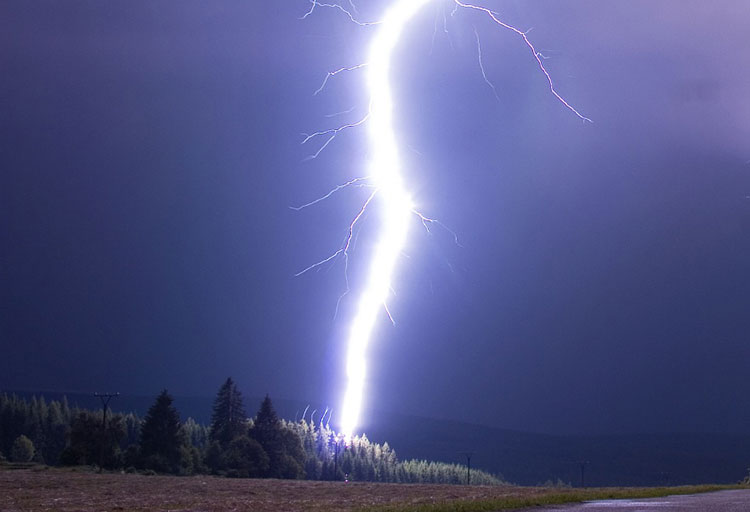
The broader effect of the significant net increase in atmospheric plasma formation is a more efficient cleansing of our polluted skies, through electrical chain reactions known to produce the abundance of nitric oxides and ozone crucial to the natural rebalancing of atmospheric gases. There is yet another, more essential purification of atmospheric hydrogen that takes place in sprites, jets and lightning strikes relating to the elimination of deuterium, a heavy isotope of hydrogen comprising 0.0156% of terrestrial waters. Deuterium content in atmospheric water vapor presents a vertical distribution gradient by gravity, with greatest concentrations of heavy water molecules near sea level, decreasing steadily with altitude.
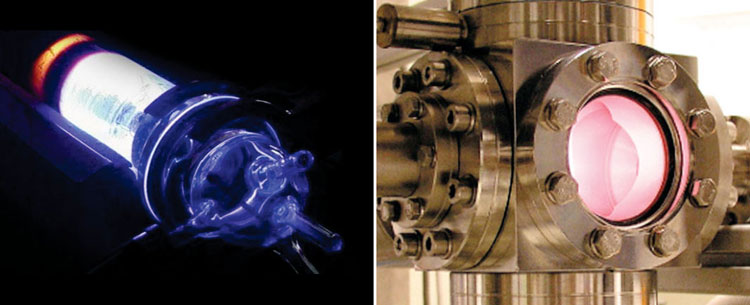
The latest advances of modern atmospheric sciences and atomic physics reiterate the ancient wisdom of the Vedas, as well as the Maya culture of Central America, concerning the sacred purification processes of nature's water cycle. Sanskrit descendant cultures have built hundreds of monumental stone pyramids on every continent and island chain, forming a wireless network resonating at the 1.45 Hz heartbeat frequency and enhancing atmospheric water purity by resonant production of light water and the resonant elimination of heavy hydrogen isotopes from our skies. After centuries of disuse and dormancy, this advanced antediluvian technology of our Atlantean forbearers is now roaring back to life, with each progressive outburst of solar flares driving every atom of our planet into states of greater coherence.
Emulating atmospheric HHO plasma formation in quartz vacuum chambers, chemist/physicist R. Mills has developed HHO plasma reactors (above) that sustain excess energy production by implosion of hydrogen atoms to form hydrinos, in a complex process that has been validated by Rowan University researchers. Laboratory findings revealing the unique dynamics of HHO resonant-transfer plasma inform the atomic reactions of lightning. As raindrops and water vapor in the storm cell create an electrical pathway for the ionospheric discharge, water molecules are rapidly ionized, undergoing low energy nuclear fission of deuterium atoms into protium atoms, with the ejected neutrons numbering upto 5,000/m3:
Russian scientists... installed three neutron detectors that were sensitive to low energy neutrons: one above ground, one partially shielded in a building, and a third underground... The cosmic rays generate muons that collide with something in or very near the detector, resulting in neutrons that have the high energy of the muon being registered. Neutrons from lightning, on the other hand, can only have the energy given up by a fission event, which is then lost in collisions with molecules in the air as they travel to the detector... In the previous experiments, it had been assumed that each detection event corresponded to a single neutron, [whereas] the new data show that up to 5,000 neutrons per cubic meter are produced every second by lightning strikes...
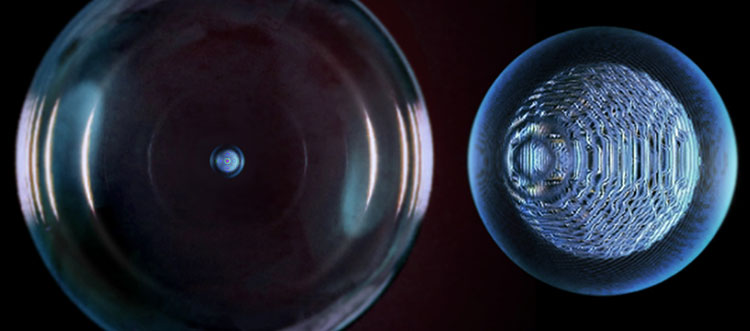
The plasma formations of lightening and aurora have been replicated for study. At Blacklight Power, Mills has defined the high-energy states of hydrogen as an implosion process that releases vast amounts of energy through emission of infrared and ultraviolet light. During the formation of HHO plasma from water vapor, heavier deuterium isotopes are resonantly converted into protium as neutrons are ejected from the nuclei, represented by the conversion equation [ D2 = H1 + n ]. Densely concentrated resonant nuclear transmutations of deuterium into protium remain the only viable explanation for the origin of neutron flux released by atmospheric HHO plasma briefly generated during lightning strikes.
Precision tuning of this resonant conversion process of deuterium into protium allows bulk purification of drinking water for human consumption, as even slightly deuterium-depleted water has been observed to reduce and kill cancers, as well as significantly reducing rates of cellular aging. Significant extension of the average human lifespan will become measurable as light water becomes publicly available.
Nuclear fission reactions of deuterium in lightning have not been previously identified, yet deuterium fusion reactions within metal substrates have been widely reported. The low energy fusion of deuterium atoms to form helium within a palladium lattice produces excess heat during electrolysis with heavy water, while later experimentation achieved slightly greater efficiency by applying electron polarization. An emerging understanding of the complex nuclear dynamics of resonant conversions of lighter gases into heavier gases promises a full revelation of the atmospheric balancing processes protecting all life.
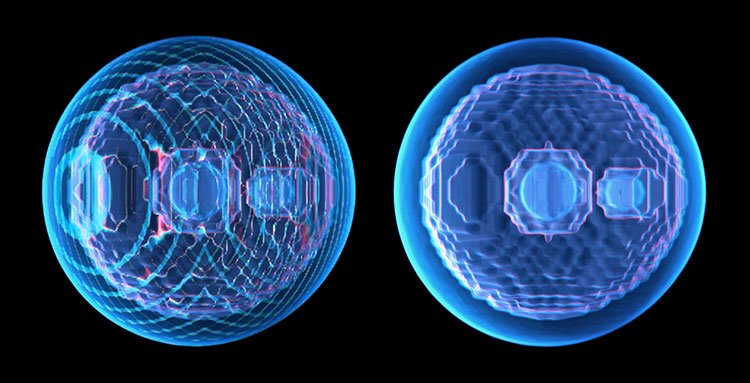
Mathematical modeling of the nuclear recombinations that occur during low energy atomic reactions has been achieved by applying the nonhomogenous Burgers equation for nonlinear standing waves. Accurate visualization of the deuterium nucleon describes the standing wave fields surrounding the proton and neutron, solved as the 'Two-Body Distribution Probability of a Nucleon' (above, rendered by R. Zirbes).
The standing wave structure of the electron was predicted by this author after research into Sanskrit mandala artifacts from La Maná, Ecuador in 2004-07 that display ultraviolet fluorescent inlays encoding the quantum quadratic function [ zn+1 = zn2 ], being closely related to the Mandelbrot set [ zn+1 = zn2 + c ], and directly observed for the first time by Swedish researchers in 2008. Ancient Vedic knowledge of nonlinear standing waves underlies all of the holistic consciousness technologies of our deep past and imminent future, opening the door to resonant processes for converting one element into another.
The natural abundance of pure metals present in Earth's atmosphere and lithosphere appear as solid deposits and reduced particles of all sizes. Microbial and oxidative processes constantly reduce metal surfaces into nanoparticles, while geological forces liquefy and separate metals by density. Extensive interdisciplinary study has revealed that both geological and biological processes induce low energy atomic nuclear transmutations at specific resonant temperatures, in the presence of specific gases.
Extensive investigations by French biologist C.L. Kervran (1901-1983) revealed the natural simplicity of biological transmutations occurring in multitudes of vital processes by replicating nuclear conversions as simple electrochemical reactions in vitro. [Kervran, CL (1964) 'Transmutations A Faible Energie: Synthèse et Devéloppement' Libraire Maloine; and Kervran, CL, tr. Rosenauer H&E (1972) 'Biological Transmutations' Swan House Pub. Co.]
Kervran defined resonant nuclear reactions as reversible, and involving both fusion and fission events between gases, metals, nonmetals and earths. His simple in vitro demonstration of the oxygen-dependent low energy atomic conversion of carbon into iron was reported in 1962, wherein ultrapure carbon rods were used as electrodes in an aqueous discharge system. Sediment analysis confirmed the fusion of two carbon atoms with two oxygen atoms in the formation of iron.
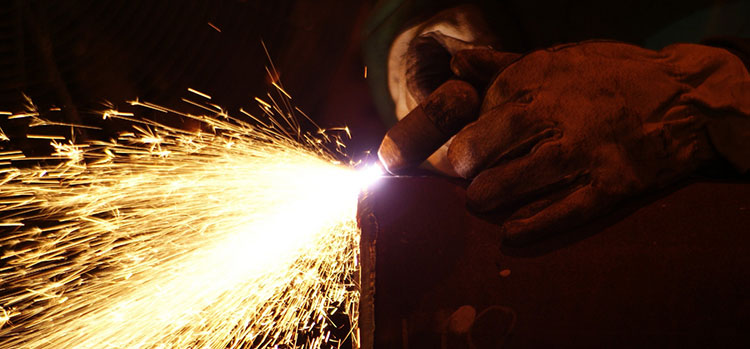
Multiple government-funded investigations into recurring cases of fatal carbon monoxide poisoning of steelworkers in France were finally concluded with Kervran's definitive 1964 demonstration under controlled laboratory conditions that lethal quantities of carbon monoxide are generated during steel plasma-cutting processes over 400°C by low energy nuclear transmutations of nitrogen gas. The fact that carbon monoxide is not formed below this critical temperature threshold is consistent with advanced atomic resonance calculations derived decades later, providing a basis for the determination of optimal temperature ranges for all such resonant atomic reactions that occur throughout natural systems.
Kervran's groundbreaking studies of various other heat-induced atmospheric and lithospheric processes led to his identification of several essential nuclear transmutations -without which such processes cannot be understood- finding that airborne pairs of nitrogen atoms readily combine to form silicon at the edge of the thermosphere. A similar fusion event was identified in volcanic reactions where pairs of carbon atoms merge in the formation of magnesium, while pairs of oxygen atoms merge to form sulfur. The natural abundance of elements and the specific isotope ratios produced in thermospheric and volcanic processes provide compelling evidence for low energy nuclear reactions as the unified driving force of nature.
Various researchers have obtained significant evidence for biological transmutation as the origin of calcium from nuclear conversions of sodium, magnesium, potassium and silicon in a wide range of organisms that secrete calcium from one side of a membrane to produce protective shells. Experiments showed that avian and reptilian species deprived of dietary calcium were incapable of producing solid eggshells unless provided with a dietary source of silicon that was readily converted into the calcium required for normal eggshell development. Similar experiments with crustacean species deprived of environmental calcium sources revealed their ability to supplant calcium with magnesium to facilitate normal shell development.
Kervran also determined that calcium formation during tooth enamel and bone growth processes in all vertebrate species was mitigated by the same substitutive resonant nuclear reactions of magnesium and oxygen fusing to form calcium, as well as another notable reaction -carbon fusing with fluorine to form phosphorus. The reversal of the latter process was identified in the bacterial digestion of bone, with phosphorus undergoing resonant fission into carbon and fluorine daughter isotopes. The constant emission of fluorine gas during bone decomposition is relied upon in the dating of fossil specimens, yet its genesis as a fission product of bacterial digestion remains the only viable explanation.
Soil productivity is another area that Kervran's biological transmutation research has benefitted, after his unique findings concerning utilization of copper by wheat plants for resonant conversion into manganese. Initial attempts to increase manganese levels in wheat by the addition of manganese to soil proved fatal to test plants, while extensive trials by wheat farmers in Alberta, Canada confirmed Kervran's findings that supplementing soils with bluestone copper rebalances manganese and doubled soil productivity.
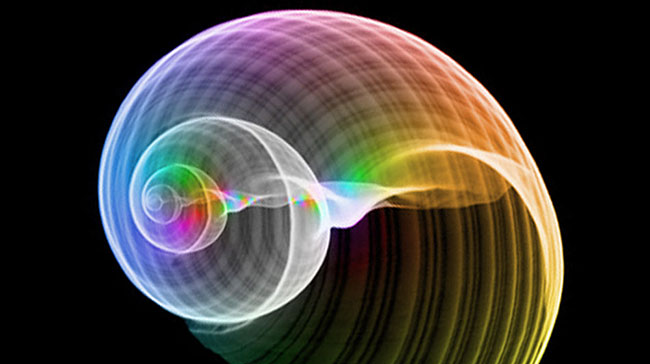
Kervran further applied his comprehensive findings to resolve many commonly misunderstood biomineral deficiencies in humans involving the biological transmutation of all essential elements as magnesium, calcium, manganese, iron, copper and zinc. In fact, it is known that calcium deficiency and resulting bone-depletion cannot be reversed by calcium intake. Calcium is now widely supplemented with magnesium, but the underlying mechanism can only be satisfactorily explained by resonant atomic transmutation. Hard evidence for fusion of magnesium and oxygen atoms is found in measurable Ca44 depletions in all bone.
An identical situation exists in dietary supplements manufactured for both iron and copper, which must be given together to achieve rebalancing of either essential element, as blood metabolism involves the resonant conversion of one element into the other. Comparative study of the three main varieties of animal blood --green, blue and red-- reveal distinct sets of nuclear reaction cascades taking place within narrow resonant temperature bands enabled by thermocline migration and thermoregulation strategies.
Cellular respiration processes in all green-blooded organisms, including ascidian, holothurian and sponge species, exhibit an alternate transmutation of iron that closely relates to those used by red- and blue-blooded species (vertebrates, cephalopods, gastropods and crustaceans). Fission of iron atoms forms titanium and vanadium in green blood while in red blood the fusion of iron and oxygen forms copper and in blue blood the fission of copper atoms forms oxygen, manganese and iron. When one considers that constantly cycling cascades of nuclear reactions underlie the essential functions of all biological systems, acting as radiant biological holographic projectors, all previously inexplicable animal and plant behavior displaying group synchrony and coherent mass communication can be understood as nonlinear biophoton field coupling effects occurring within the range of visible light.
Researchers Widom, Srivastava and Sivasubramanian have redefined the well-established properties of biophotons as products of atomic nuclear reactions, drawing conclusions that parallel those established by Kervran in their 2011 paper, entitled 'Biological Nuclear Transmutations as a Source of Biophotons':
We have shown that soft multi-photon radiation from hard higher energy reactions sources can be employed to describe the three major well-established properties of biophoton radiation. Since the soft photon frequencies span the visible to the ultraviolet frequency range, the hard reaction sources have energies extending into the nuclear transmutation regime. Thus, the biophotons serve as a valuable clue as to which biological systems exhibit a large number of nuclear transmutations.
Kervran's observations of human skin and sweat gland processes inspired laboratory experiments in 1959 that clearly demonstrated the low energy nuclear fusion of sodium and oxygen to form stable potassium, which contributes to the overall biophoton emissions observed of human skin surfaces. This surprising resonant atomic reaction was later replicated by ionizing sodium vapor in the presence of oxygen under spectrographic observation (Torii, Sakurazawa, Odagiri, 1963; Ohsawa, Kushi, 1964).
Recent investigations of the ultra-weak visible luminosity of the human body have applied direct biophoton detection by ultra-sensitive light-amplified CCD cameras that accurately record subtle diurnal fluctuations in the distribution patterns within human biophoton fields over time. The re-emission of absorbed photons observed in living cells is identified as 'delayed luminescence' in the hours after exposure. Multiple sources comprise the perpetual and spontaneous biophoton emissions of all cells. Biophysicist F.A. Popp and his research team have reported remarkable series' of images of the weak human glow during traditional acupuncture and moxibustion therapies (below), clearly revealing the left-right symmetry of the healthy body and biorhythmic cycles of 14 days, 1 month, 3 months and 9 months.
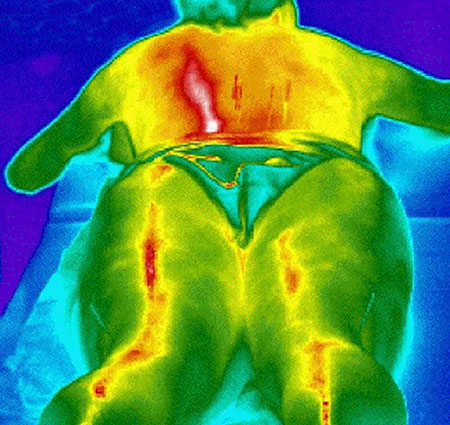
Popp's focus has narrowed to investigations of the nonlinear photon trapping of DNA as a coherent broadband visible light biocommunication system, emitted from within the chromatin in the nucleus of each cell. DNA base-molecules and surrounding cell walls act as quantum resonators, efficiently storing light by internal reflection of nonlinear standing waves. These findings inform a radical recharacterization of chromatin as an exciplex laser array, with DNA base pairs now recognized as 'excited complexes' that emit photon fields displaying constructive or deconstructive interference modes. Studies found that DNA conformation and skin conductivity directly correlate with biophoton emission intensity.
Areas of the human body that emit the greatest intensity of photons (seen above in yellow, red and white) correspond closely to the circulatory system. Along with the heart, large superficial veins and arteries present the greatest biophoton emission and highest electrical conductivity in the body. Blood is more saline than other bodily fluids, and full of iron-bearing hemoglobin, contributing to a conductivity that is higher than the rest of the body's systems, acting as an extension of the electromagnetic field of the beating heart by maintaining an electronically excited state exhibiting coherent oscillations:
Monitoring of spontaneous and luminophore amplified photon emission (PE) from non-diluted human blood under resting conditions and artificially induced immune reaction revealed that blood is a continuous source of biophotons indicating that it persists in electronically excited state. This state is pumped through generation of electron excitation produced in reactive oxygen species (ROS) reactions. Excited state of blood and of neutrophil suspensions (primary sources of ROS in blood) is an oscillatory one suggesting of interaction between individual sources of electron excitation. Excited state of blood is extremely sensitive to the tiniest fluctuations of external photonic fields but resistant to temperature variations as reflected in hysteresis of PE in response to temperature variations. These data suggest that blood is a highly cooperative non-equilibrium and non-linear system, whose components unceasingly interact in time and space. At least in part this property is provided by the ability of blood to store energy of electron excitation that is produced in course of its own normal metabolism.
Oscillatory excitation of the electronic state of blood by ROS reactions coordinates enzymatic activities and enhances the absorption of dissolved gases by metal nanoparticles in the blood, especially lithium, chromium, manganese, iron, nickel, copper, zinc and selenium. Hemoglobin within red cells acts as a reducing agent that synthesizes iron nanoparticles in the 2-5 nm range for optimized binding with oxygen during circulatory transport.
Precision control of the pressure differential of dissolved oxygen levels maintained between red cell membranes and the surrounding blood plasma is accomplished by temperature-dependent transport interactions with sodium and potassium cations. Kervran's elucidation of the electrically enhanced nuclear fusion of sodium and oxygen to form stable potassium occurs under the conditions maintained in healthy blood, in conjunction with nuclear fission reactions induced by the phonon resonance of metal-bound oxygen atoms with hydrogen at rest.
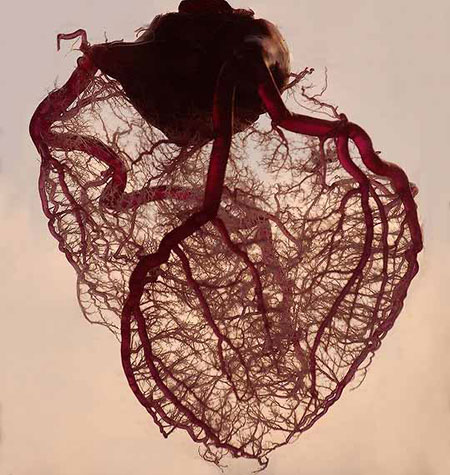
The indispensible role of absorbed oxygen atoms in the resonant nuclear conversions of sodium into potassium and iron into manganese directly implicates these reactions as primary mechanisms for blood's rebalancing of crucial metal concentrations, thus enabling effective utilization of a wider ratio of available metals to fulfill the well-known respiratory functions as well as the newly discovered biophotonic functions of blood medium.
This conclusion is directly supported by isotopic signature studies of trace metals in mammals and plants, which diverge significantly from the great abundance of dietary metal sources and those of all geological deposits. Trace copper isotope ratios in human blood consistently present a Cu65 variation of +0.30% as compared with non-biological copper, being enhanced by the fission of zinc atoms to form copper.
Isotopic shifts of iron in human blood enable gender determinations of partial skeletal remains, with male blood presents Fe56 depletions of -2.5% to -2.9%, suggesting heavier iron isotopes do not concentrate in the blood serum of females due to regular menstrual blood loss and the enhanced iron absorption that compensates for such periodic deficiency. This hypothesis is supported by findings that hemochromatosis, characterized by excess iron levels and heavy iron isotope concentrations, is alleviated by phlebotomy (the removal of blood). Such notable isotopic shifts that perpetually accumulate during blood recirculation implicate the atomic weight disparity as produced by perpetual resonant nuclear transmutations of iron.
The surprising conclusions established by Kervran's in vivo biological transmutation experiments have not been thoroughly followed-up by biophysicists despite the ever growing body of solid evidence for nuclear conversions occurring in all living organisms. The compelling case of biological transmutations informs the open questions of biophotonics by synthesis with the formulaic framework of phonon resonance developed by W. Lussage in 1965 and confirmed in microbial transmutation studies by J. Champion in 2001:
Dimensional phonon resonance occurs when the space occupied by one isotope is exactly the same as that of another isotope in its rest state [i.e. 20°C]. This event can only occur under the following two conditions: the expansion of an isotope by heating, or the contraction of an isotope by cooling. Due to the natural characteristics of elemental properties, this event is extremely rare and one can only force the event under select conditions. To determine the phonon resonance of an isotope, it is necessary to apply the following formula:

Phonon resonance calculations reveal the elusive quantum dynamics of lattice interactions that induce low energy nuclear reactions throughout the bodies of living organisms, as first identified by Kervran decades earlier. Precise calculations of the exact atomic diameters of various isotopes were only recently enabled by the careful determination of exact atomic masses, densities and linear thermal expansion coefficients for all known isotopes -data that was not available during Kervran's discoveries of biological transmutations, and comprises undeniable evidence for his conclusions.
Atomic data for each isotope applied in these calculations (in blue) was obtained from various updated sources, while the exact atomic mass figures are consistent with tables produced by the Secondary Ion Mass Spectrometer (SIMS) Laboratory of the GeoForschungsZentrum in Potsdam, Germany.
The evolution of red-blooded mammals has specifically exploited the phonon frequency interactions of gases and metals in the blood for producing excited electron states that have yet to be fully understood. Phonon vibration of individual oxygen atoms bound to iron atoms in hemoglobin enables the resonant atomic recombination process by instilling the target frequency of daughter elements.
Quite surprisingly, the atomic diameters of O and H atoms are relatively similar despite their difference in atomic mass, allowing for frequency matching possibilities near room temperature. As oxygen atoms are driven through repeating heat fluctuations by cyclical movement through the human body, frequency matching with hydrogen atoms occurs in the warmer areas before slowly dropping in the extremities. The resonant frequency of hydrogen (H1) in its rest state is 3,773,180 Hz, according to the element's atomic diameter at 20°C. Oxygen isotope (O16) resonates at this same frequency when heated to 37.8°C:
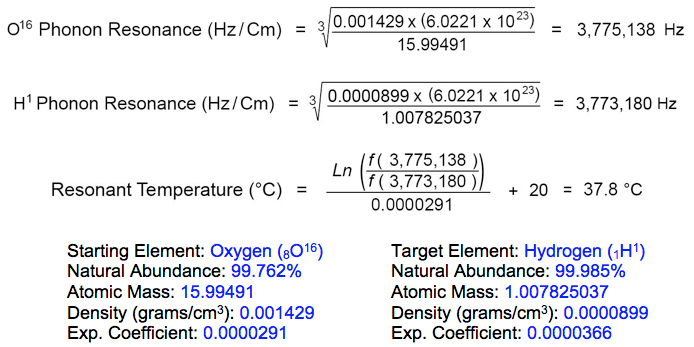
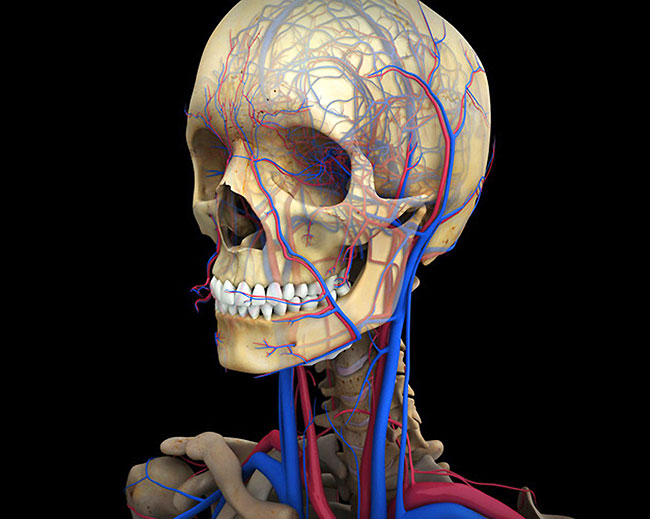
Blood circulating within the heart and large arteries maintains temperature near 38.0°C, slightly elevated above average core body temperature near 37.0°C. This significant variance of blood from the mean human body temperature induces rhythmic thermal fluctuations in blood cells according to their cyclical transport from the warm heart to the slightly cooler extremities and skin capillaries. During circulation, fission of iron atoms releases hydrogen atoms by phonon induction of bound oxygen atoms at 37.8°C:

The narrow temperature requirement of the healthy human body are calibrated to the phonon frequency matching threshold of oxygen atoms with hydrogen atoms within the heme groups of erythrocytes. Recognition of this atomic reaction offers a new view of hemoglobin and myoglobin proteins as nuclear transmutation nanomachines, efficiently reducing iron nanoparticles into individual atoms for binding with oxygen molecules during transport, while electrical currents in the bloodstream dissociate iron-bound O2 molecules to excite atomic recombinations releasing hydrogen. By this mechanism, nuclear conversion rates are enhanced by natural exposure to electric current through barefoot contact with the Earth.
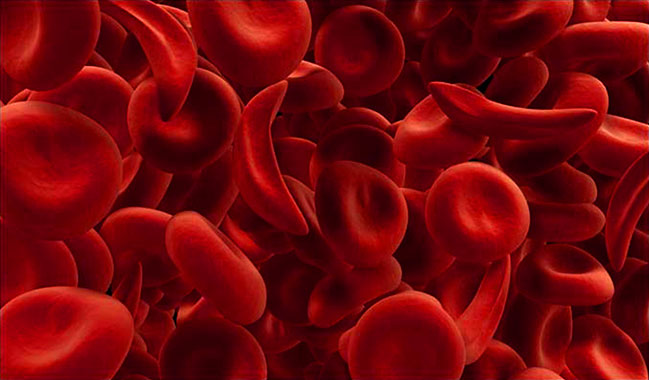
Further studies of isotope variations in trace elements of the human body will identify specific contributors to exciplex photon cascades observed as biophotons. The wide variety of metals present in healthy human blood and their respective concentrations endow the fluid medium with complex resonant characteristics only now being recognized as phonon resonance dynamics of the metal crystal lattice.
The frequency matching 'architecture' of phonon resonance relationships maintained in healthy blood trigger the release of electrons that, together with ROS processes, excites the blood by a surprisingly rich variety of nuclear reactions that provide the first comprehensive explanation for the diversity of trace metals in blood. Reactions of iron and oxygen conform to a pattern also witnessed in the other elements.
The varied combinations of gases and metals in red blood present an array of potential reactions that may be occurring within the range of temperatures maintained by different portions of the human body, and requires thorough experimental confirmation in every case. Refining the volume expansion coefficients for gases will be an important step toward designing a comprehensive set of experimental procedures for determining the full hierarchy of atomic conversion cascades that vitalize the human body.
Thermoregulation in warm-blooded mammals is apparently calibrated to phonon relationship of oxygen with hydrogen. The pattern of resonant atomic reactions that best explains observed isotopic variations are listed for several other predominant isotope recombinations, following the same basic formula as iron:
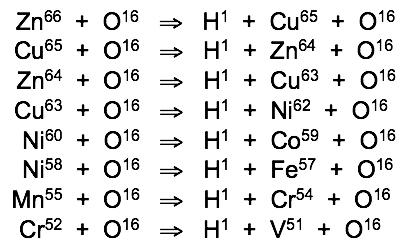
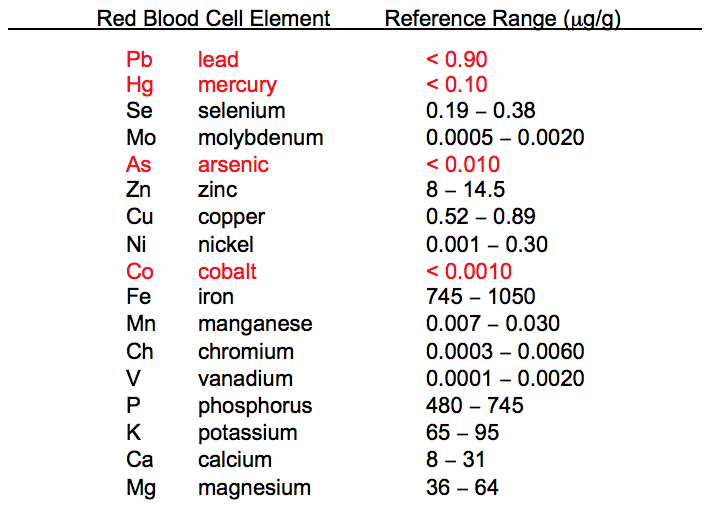
Nominal concentration ranges for trace elements in human red blood cells reveal the presence of several elements in healthy individuals that can accumulate to potentially toxic levels (in red, above). The origin of exotic trace elements such as arsenic and cobalt generally present in the bloodstream may be explained by perpetual phonon-enabled reactions of oxygen bound with nickel and selenium at 37.8°C, where oxygen achieves resonance at the target frequency of hydrogen atoms at rest (20°C):

An interesting case of alternating isotopes of adjacent elements found in red blood cells relates to the relationship of potassium and calcium, which convert from one to the other in a cascade series:

Another similar relationship may be discerned in the case of the essential elemenets magnesium and sodium, occurring by the phonon induction of oxygen bound with magnesium in red blood at 37.8°C:

These most abundant isotopes found in human blood are simultaneously converting within the same very narrow temperature band, revealing the essential role of phonon relationships among gas atoms in the bloodstream. Upon confirmation of these findings, one must inevitably conclude that the innate phonon resonance relationships of stable isotopes in adjacent element groups fulfill the primary purpose of providing all living systems with resonant temperature ranges for generating nuclear reaction cascades.
Resonant nuclear interactions of matter form the basis of life throughout the vast reaches of the cosmos, and warm-blooded beings similar to mammals on Earth likely inhabit innumerable galaxies by exploiting tuned nuclear reactions releasing photon cascades by multiple resonant metal conversions near 37.8°C.
This unmistakable pattern of phonon resonance conversions demonstrated between the predominant metals of human blood directly reveals the primary fundamental principle within the universal isotopic architecture of all matter that enables all living organisms to maintain excited states for coherent electro-photonic field communication. These remarkable conclusions offer the only comprehensive explanation for the observed natural isotopic order and the precision temperature regulation of living organisms.
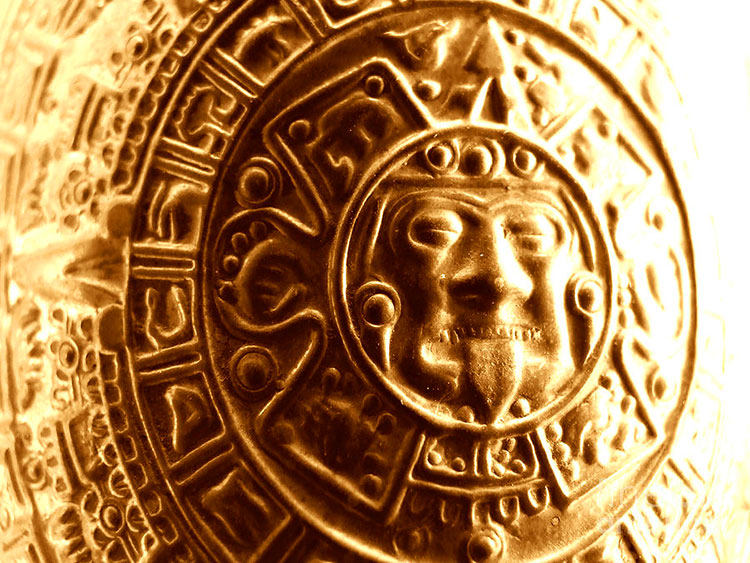
The precise tuning of nuclear transmutations resonantly induced by the exact temperature of human blood provides a new biophysical framework for the integration of the ancient energy balancing practices of Asia, in addition to the Vedic prana development practice of sungazing known to all monumental stone builders worldwide. Modern sungazers practicing such ancient techniques include Anastasia, Sunyogi Umasankar, Hira Ratan Manek, Acharya Jowel and Dimbeswar Basumatary, all of whom derive the majority of their energy directly from the sun while completely abstaining from the normal metabolic consumption of food.
Ancient traditions of the Maya teach the initiate that solar (photonic) energy of the heart is stored within the (DNA) serpent or 'coatl' for utilization by strict adherence to sacred cultural bioelectrification practices. Biophysicists have already determined that all cellular metabolic functions can be fueled directly by exposure to electrical current, and it is now evident that drinking the celestial golden waters of the Maya in caves and at pyramid sites, barefoot, induces electroluminescence in gold and silver nanoparticles that scatter red and blue light within the body's cells.
Intracellular luminosity is the key to enhanced vitality and the extreme longevity ascribed to the Atlantean masters of consciousness, who make the explicit acknowledgement that 'gold is immortality', referring to electrum colloids as the elixir Soma: "The man who supplies food hath always [his Soma] pressing stones adjusted, a wet Soma filter, well-prepared religious rites... he who hath this knowledge wins the luminous spheres" (Atharva Veda: IX.6). A Sanskrit descendant culture, the Maya preserved the Vedic calendar system (above) observing planetary cycles and resulting biophotonic cycles of 14 days, 1 month, 3 months and 9 months - a human gestation cycle. Maya wisdom explicitly states human beings attain immortality by regular sungazing meditation at sacred temple sites, thereby engaging the eyes in completion of the solar circuit, absorbing and re-emitting photonic energy directly back to the sun:
Chalchiuhtlicue, Goddess of Terrestrial Waters, of that which flows, runs, surges, forward and down, arriving always at profounder levels. Chalchiuhtlicue swells the fruits and flowers only so that they may drop. Chalchiuhtlicue fills the gourd of pulque so that man may forget...
Tláloc, God of Celestial Water, god of the vapor that rises, from the earth warmed by the sun after the rains, god of the mist that ascends from the valleys at dawn, god of the water that returns to its source in the clouds that swim over the highest peaks, god of the humid incense from which rise the copal prayers and the prayers of sacrifice.
Tláloc is the return of vapor that strains to rise, is the return of time that strains to remember. Tláloc, God of the Fight Against the Current, with whose aid the hero battles against the torrent toward his own origin and beginning, towards the wings of his soul, the wings that Tláloc hides in the hero's past.
Quetzalcóatl, the Plumed Serpent, moves between gods and men, because Quetzalcóatl is God who permeates man and is the man that achieves God... The Plumed Serpent is born when that which slithers over the Earth grows wings to be elevated to Heaven. Quetzalcóatl is a superior man, the inner circle of humanity, the link between gods and men.
All men are made of earth, air, water, and fire... But in their hearts and in their semen, each man has his own coati, his own serpent, the energy of Tonatiuh, the power of the sun itself. And in this serpent sleeps consciousness, in this serpent is hidden his divinity. From this serpent his wings will grow.
There is an occult energy in the heart that comes from Tonatiuh, the sun, and if man releases it, returning it consciously to the sun, he becomes immortal. But to liberate this energy... man must sacrifice the desires and habits that he adores, sacrifice them in himself, and turn the knife against the enemy that he carries within himself, that keeps his heart a prisoner.
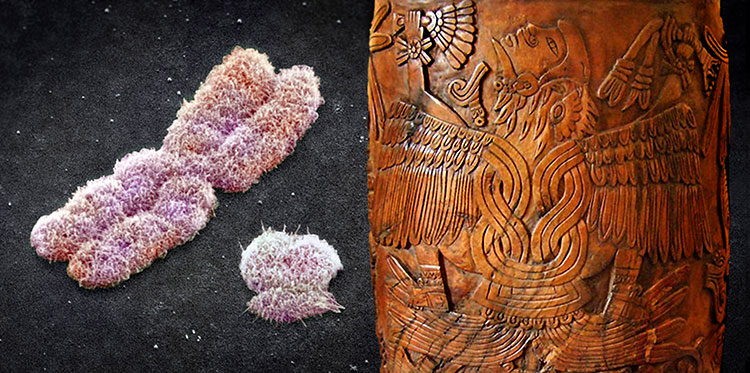
Well-preserved masterworks of painting and sculpture by Aztec and Mayan artists attest to their prolific intellectual life, with Gods representing the transcendent isotopic qualities of water and fire. Tláloc, God of Celestial Waters represents light water (and all that biophysics now attributes to the effects of protium on cellular longevity), standing in opposition to Chalchihutlicue, Goddess of heavy Terrestrial Waters.
Quetzalcóatl presents the spiritual path of superior man who adheres to sacred bioelectrification practices, depicted as the Eagle Warrior with tail plumes forming standing waves (above, right). The k'ulthanlilni serpent is depicted rising through the chacla (Mayan for 'kundalini' and 'chakras') to form wings as three lines weaving in helices along the spinal column -representing the three frequency modes of nonlinear standing light waves stored in the DNA spiral. Floral mandalas adorn the wrists of ascending Quetzalcóatl, with tassels that can be clearly recognized as chromosomes, bearing coiled DNA strands (above, at left).
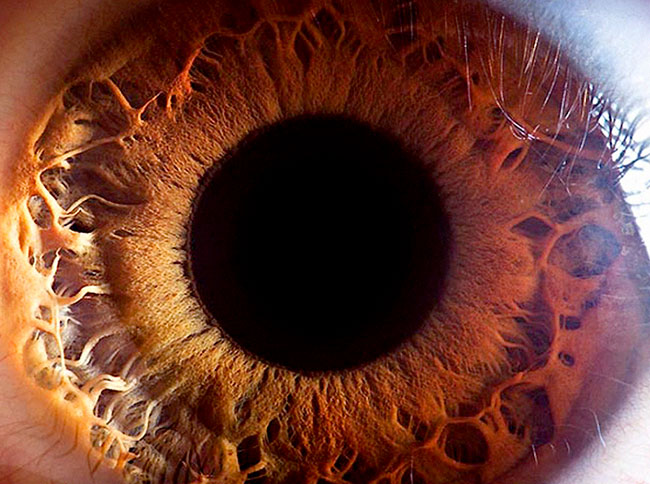
Biophysical studies have recently reconfirmed ancient sacred knowledge that, indeed, human eyes emit light, as first observed in rat eye retinas and reported in 2010 (Wang, et al). Spontaneous biophoton emission measured by the researchers is comprised of soft photon scattering from continual atomic conversions pervading the network of fine blood vessels behind the retina, which forms a loose spiral centered behind each eye. The lens of the eye may not only focus environmental light onto the retina, but also focus ultra-weak biophotons re-emitted from the retina into a beam centered along the line of sight. Such findings confirm Maya elucidations of the solar circuit completion by ocular photon emissions.
Barefoot contact with the piezoelectric pyramid stones provides electrical currents that excite atomic reactions within the blood by increasing the rate of molecular dissociation of gas molecules adsorbed to metal surfaces, effectively increasing the rate of gas absorption into metals. Just as Qigong and Reiki adepts practice regular meditation in conjunction with barefoot lifestyles at sacred sites, related holistic energy balancing practices such as acupressure, acupuncture, cupping and moxibustion are resonantly amplified by sacred bioelectrification lifestyles that excite the body's nuclear transmutation processes.
Copyright 2012-2015 Alexander Putney